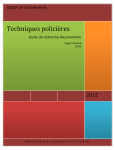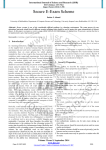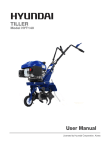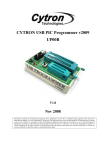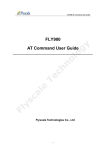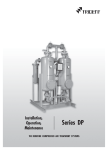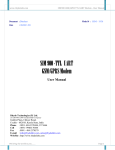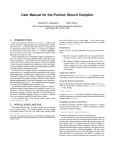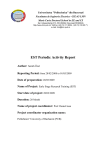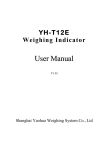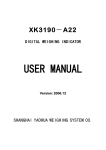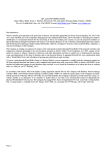Download Design of Embedded Systems for Drip Irrigation Automation
Transcript
International Journal of Engineering Science Invention ISSN (Online): 2319 – 6734, ISSN (Print): 2319 – 6726 www.ijesi.org Volume 2 Issue 4 ǁ April. 2013 ǁ PP.34-37 Design of Embedded Systems for Drip Irrigation Automation Jyothipriya.A.N.*, Dr.T.P.Saravanabava ** Department of Electrical and Electronics Engineering, College of Engineering, Anna University, Chennai. ABSTRACT: In this paper, the Design of Embedded system for the Automation of Drip irrigation is presented. Water is very precious to all the humans and as well as to the plants, trees. The major amount of fresh water is utilized by the agricultural industry for irrigation. Rural areas in many states of India are plagued by frequent power cuts and abnormal voltage conditions. In this paper the design of a Microcontroller based drip irrigation mechanism is proposed, which is a real time feedback control system for monitoring and controlling all the activities of drip irrigation system more efficiently. Irrigation system controls valves by using automated Solenoid valves to turn ON & OFF the main gate valves for specified time through zigbee controller whenever normal voltage conditions exists. This allows the farmer to apply the right amount of water at the right time. Information is exchanged in form of sms (Short Message Service) between the system and the user cell phones. The system is based on PIC18F452 micro-controller, RTC DS1307, Solenoid valve and Zigbee module and includes protection against single phasing, over-current, dry running. This system will relieve hardships of farmers from manual operation of turning on/off of main gate valves for water distribution to a great extent. Keywords:Drip Irrigation, PIC 18F452 Microcontroller, PIC 16F690 Microcontroller, CT1270 Current Sensor, RTC DS 1307, RFM 70. I. INTRODUCTION Water is considered to be basic need of human. Water is needed for everyone human beings, animals, plants, etc.Agriculture is one of the fields where water is required in tremendous quantity. Nowadays, water shortage is becoming one of the biggest problems in the world. So wastage of water is a major problem in agriculture since it limits the coverage of cultivable area. Every time excess of water is given to the fields if conventional irrigation system is used. Different types of irrigation schemes are used for better conservation and management of water in agriculture. Types of Irrigation Systems Ditch Irrigation Ditch Irrigation is a rather traditional method, where ditches are dug out and seedlings are planted in rows. The plantings are watered by placing canals or furrows in between the rows of plants. Siphon tubes are used to move the water from the main ditch to the canals. This system of irrigation was once very popular in the USA, but most have been replaced with modern systems. Terraced Irrigation This is a very labor-intensive method of irrigation where the land is cut into steps and supported by retaining walls. The flat areas are used for planting and the idea is that the water flows down each step, while watering each plot. This allows steep land to be used for planting crops. Drip Irrigation This is known as the most water efficient method of irrigation. Water drops right near the root zone of a plant in a dripping motion. If the system is installed properly you can steadily reduce the loss of water through evaporation and runoff. Sprinkler System This is an irrigation system based on overhead sprinklers, sprays or guns, installed on permanent risers. The system buried underground and the sprinklers rise up when water pressure rises, which is a popular irrigation system for use on golf courses and parks. Rotary Systems This method of irrigation is best suited for larger areas, for the sprinklers can reach distances of up to 100 feet. The word “Rotary” is indicative of the mechanical driven sprinklers moving in a circular motion, hence reaching greater distances. This system waters a larger area with small amounts of water over a longer period of time. www.ijesi.org 34 | P a g e Design Of Embedded Systems For Drip Irrigation Automation In that Drip Irrigation is known as the most water efficient method of irrigation. Water drops right near the root zone of a plant in a dripping motion. If the system is installed properly it can steadily reduce the loss of water through evaporation and runoff. Automatic irrigation systems provide convenience, especially for those who travel. If installed and programmed properly, automatic irrigation systems can even save power and help in conserving water through programmed discharge of precise amounts of water in a targeted area, using solenoid valves to turn irrigation ON and OFF and these valves may be easily automated by using controllers, which promotes water conservation. Here the automation process is done through the wireless GSM (Global System for Mobile Communications) and Zigbee technologies. For the efficient usage of the device the end user should know the basic of Short Message Service (SMS) operation which is more than sufficient to use this device efficiently. II. LITERATURE SURVEY A. Design of Micro controller Based Drip Irrigation System The key elements that should be considered while designing a model: a) Flow: - Output of water supply is measured using one or five gallon bucket and a stopwatch. Time how long it takes to fill the bucket and use that number to calculate how much water is available per hour. litres per minute x 60=number of litres per hour. b) Pressure (The force pushing the flow): – Most products operate best between 20 and 40 pascals of pressure. Normal household pressure is 40-50 pascals. c) Water Supply & Quality: - City and well water are easy to filter for drip irrigation systems. Pond, ditch and some well water have special filtering needs. The quality and source of water will dictate the type of filter to be used. d) Soil Type and Root Structure: – The soil type will dictate how a regular drip of water on one spot will spread. Sandy soil requires closer emitter spacing as water percolates vertically at a fast rate and slower horizontally. With a clay soil water tends to spread horizontally, giving a wide distribution pattern. Emitters can be spaced further apart with clay type soil. A loamy type soil will produce a more even percolation dispersion of water. Deep-rooted plants can handle a wider spacing of emitters, while shallow rooted plants are most efficiently watered slowly (low gap emitters) with emitters spaced close together. On clay soil or on a hillside, short cycles repeated frequently work best. On sandy soil, applying water with higher gap emitters lets the water spread out horizontally better than a low gap emitter. e) Timing: -Watering in a regular scheduled cycle is essential. On clay soil or hillsides, short cycles repeated frequently work best to prevent runoff, erosion and wasted water. In sandy soils, slow watering using low output emitters is recommended. Timers help prevent the too-dry/too-wet cycles that stress plants and retard their growth. f) Elevation: - Variations in elevation can cause a change in water pressure within the system. Pressure changes by one pascal for every 2.3 foot change in elevation. Pressure-compensating emitters are designed to work in areas with large changes in elevation. g) Watering Needs: -Plants with different water needs may require their own watering circuits. For example, orchards that get watered weekly need a different circuit than a garden that gets watered daily. Plants that are drought tolerant will need to be watered differently than plants requiring a lot of water. The below is the block diagram for the automation of the drip irrigation. From figure 1 it can see that the current sensor sends the current readingsl to the microcontroller and LCD is used to display the readings. From microcontroller it sends to the water pump, user and from their it goes to the irrigation lines. Figure 1: Block diagram Figure 2: Valve control Unit www.ijesi.org 35 | P a g e Design Of Embedded Systems For Drip Irrigation Automation B. System Operation Once the three phase power comes module will send an SMS to authenticated users. If the farmer wants to switch on the motor he just needs to send an SMS to the particular modem number which is implemented near the motor. Microcontroller checks whether the SMS is received from the authenticated mobile and for favorable working condition to start the motor. If the condition doesn’t match means it will send the present status of the motor to the user. In every stage it will send the status to the farmer (authenticated mobile) i.e , whether the motor is on or off through SMS. If the farmer needs to switch off he just need to send SMS to the same number to complete the operation i.e by sending ON motor gets on and by sending OFF motor gets OFF. C. Hardware used: C.1. PIC 18F452 Microntroller PIC 18F452 Microcontroller has 16k of program memory and 1536 Bytes of RAM and because the RAM is linear and packaged in a 40 pin DIP other packages are PLCC and TQFP for surface mount) and it can be programmed in circuit using ICSP. Compared to other 18F devices it has an 8 bit hardware multiplier (8x8). It also has a 4x internal phase locked loop oscillator - an external clock signal of 10MHz and it will run at 40MHz internally but the maximum internal instruction rate is Fosc/4 so even with the PLL active (or using an external 40MHz clock) you only get 1 instruction every 4 clock cycles - the maximum you can get is 10MIPS. C.2. Current Sensor CT127 The CT Series is used for Line Frequency from 15 Hz to 50Hz/60 Hz and up to 800 Hz current sensing applications. . Current transformer uses a single turn primary. The primary winding is not built into the transformer itself. It has an opening or hole for the primary wire or cable to go through. The number of secondary turns determines the current ratio. The terminating resistor is also called the "burden resistor", and it is the resistor across the secondary terminals. The voltage across the terminating resistor is equal to Terminating Resistor divided by Number of secondary turns. This is the voltage that is being measured for current monitoring purposes. C.3. GSM Modem (SIM 900) GSM module is built with the advance SIM900 engine, works on frequencies EGSM 900 MHz, DCS 1800 MHz and PCS 1900 MHz It is very compact in size and easy to use as plug in module . The Modem is coming with RS232 interface, which allows you to connect directly to PC or microcontroller and only two wire( TX , RX ) except Power supply to interface with microcontroller. The built in Power supply allows to connect wide range unregulated power supply . Using this modem, Sending SMS, data and read SMS through simple AT command. AT COMMANDS CODE SEND A TEXT MESSAGE Goal: Read a Text AT+CMGF=1\r Returns OK or ERROR AT+CMGDA=”DEL ALL” Delete all text AT+CNMI=0,0 Disable unsolicited error code AT+CMGR=1 Read Message #1 AT+CMGL=”REC UNREAD” Read all received unread messages C.4.Zigbee Module (RFM70 Transceiver Module) RFM70 is a GFSK transceiver module operating in the world wide ISM frequency band at 2400 2483.5 MHz Burst mode transmission and up to 2Mbps air data rate make them suitable for applications requiring ultra-low power consumption. The embedded packet processing engines enable their full operation with a very simple MCU as a radio system. Auto re-transmission and auto acknowledge give reliable link without any MCU interference.RFM70 operates in TDD mode, either as a transmitter or as a receiver. The RF channel frequency determines the center of the channel used by RFM70. The frequency is set by the RF_CH register in register bank 0 according to the following formula: F0= 2400 + RF_CH (MHz). The output power of RFM70 is set by the RF_PWR bits in the RF_SETUP register. Demodulation is done with embedded data slicer and bit recovery logic. The air data rate can be programmed to 1Mbps or 2Mbps by RF_DR register. A transmitter and a receiver must be programmed with the same setting. A transmitter and a receiver must be programmed with the same RF channel frequency to be able to communicate with each other. www.ijesi.org 36 | P a g e Design Of Embedded Systems For Drip Irrigation Automation C.5. Relay (RLY102) The RLY102 provides two SPDT relays with convenient screw terminal connections for the inputs andcontacts. It includes active driver circuitry allowing lower current input signals (such as 5V TTL) to be used.LEDs provide visual indication on the status of each relay. C.6.LCD (Liquid Crystal Display) LCD screen is an electronic display module and find a wide range of applications. A 16x2 LCD means it can display 16 characters per line and there are 2 such lines. In this LCD each character is displayed in 5x7 pixel matrix. This LCD has two registers, namely, Command and Data. The command register stores the command instructions given to the LCD. A command is an instruction given to LCD to do a predefined task like initializing it, clearing its screen, setting the cursor position, controlling display etc. The data register stores the data to be displayed on the LCD. The data is the ASCII value of the character to be displayed on the LCD. Click to learn more about internal structure of a LCD. C.7. Solenoid Valve Solenoid valve is an electromechanically operated valve. The valve is controlled by an electric current through a solenoid operates at 300mA ,12V , in the case of a two-port valve the flow is switched on or off. D. Comparision between Manually operated Crop 155.4 66.6 128.5 70 WATER USE (m3/acre) Drip Automated Drip 1901 1007 2041 1161 1683 1043 2483 1488 4100 9000 81.8 45 1776 1544 1120 960 37 38 13301 67 3040 1320 57 Tomato Capsicum Lady’s Finger Brinjal YIELD (kg/acre) Drip Automated Drip 9808 25050 5340 8900 3144 7187 5044 8569 Beans Cucumber 2255 6200 Bitter gourd 7981 % saving % saving 47 43.1 38 40 E. Drip Irrigation System and Automated Drip Irrigation System. III. CONCLUSION The GSM based Zigbee Controlled Solenoid Valve for drip irrigation system proves to be a real time feedback control system which monitors and controls all the activities of drip irrigation system efficiently Using this system, one can save manpower, water and power consumption is reduced by 20% and 30% when compared to existing ACKNOWLEDGMENT I would like to express my sincere appreciation and gratitude to my guide, Dr.T.P.Saravanabava, Associate Professor, Ramanujam Computing Centre, Anna University for his guidance, constant encouragement and support. I thank the HOD, Dr.P.Vanaja Ranjan, Professor, Department of Electrical and Electronics Engineering, Anna University, for providing necessary facilities towards carrying out this work. REFERENCES [1]. [2]. [3]. [4]. [5]. [6]. [7]. [8]. [9]. [10]. [11]. [12]. [13]. [14]. [15]. Innovative Cost Effective Approach for Cell Phone based Remote Controlled Embedded System for Irrigation,Vasif Ahmed, Siddharth A. Ladhake, IEEE2011 International Conference on Communication Systems Wireless Sensor Network based Remote Irrigation Control System and Automation using DTMF code,Vandana Dubey, Nilesh Dubey, Shailesh singh Chouhan, Communication Systems and Network Technologies,978-0-7695-4437-3/11 ,2011 IEEE DOI 10.1109/CSNT.2011.14 The design of intelligent drip irrigation network control system,Yaohua Chen, 978-1-4244-7255-0/11/©2011 IEEE. MPPT Based Stand-Alone Water Pumping System, Anna Mathew, A.Immanuel Selvakumar, Computer, Communication & Electrical Technology, March, IEEE, 2010. Integration of Wireless Technologies for Sustainable Agriculture, Kalyan Mohan Goli, Karthik Maddipatla, Thentu Sravani, International Journal of Computer Science & Technology ISSN : 2229-4333(Print) IJCST Vol. 2, Issue 4, Oct . – Dec. 2011. www.janatics.com www.ccsinfo.com ww.rhydolabz.com,SIM900 GSM/GPRS RS232 Modem - User Manual. www.picmicros.org.uk www.labcenter.co.uk, Manufacturer and supplier of Proteus VSM electronic design system. Innovative Cost Effective Approach for Cell Phone based Remote Controlled Embedded System for Irrigation,Vasif Ahmed, Siddharth A. Ladhake, IEEE 2011 International Conference on Communication Systems and Network Technologies. Wireless Sensor Network based Remote Irrigation Control System and Automation using DTMF code,Vandana Dubey, Nilesh Dubey, Shailesh singh Chouhan, Communication Systems and Network Technologies The design of intelligent drip irrigation network control system,Yaohua Chen. Research on water-saving irrigation automatic control system based on Internet of things, Zhang Feng. A Prototype of PC Based Remote Control of Irrigation, Mahir DURSUN, Semih OZDEN. www.ijesi.org 37 | P a g e







